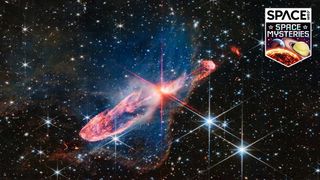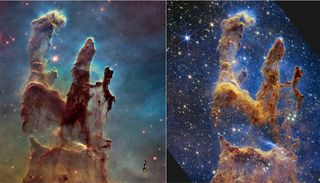What are the true colors of images from the James Webb Space Telescope?
Do these cosmic objects really look so colorful?

NASA's James Webb Space Telescope (JWST) is known for capturing our universe with unprecedented precision and sensitivity. Its images aren't only scientifically useful but also beautiful. From the blue and gold of the Southern Ring Nebula to the pink, orange and purple of Cassiopeia A, JWST images render the universe in brilliant color.
The images are so stunning, you might wonder, —do these cosmic objects really look that colorful? What would they look like if we could see them with our own eyes, instead of through a telescope?
"The quickest answer is, we don't know," said Alyssa Pagan, a science visuals developer at the Space Telescope Science Institute (STScI) and part of the team that works to bring color to the JWST images. But one thing is for sure: You wouldn't see the universe like this.
JWST is an infrared telescope, meaning it "looks" at the universe in wavelengths of light that are longer than that of red light, which has the longest wavelength we can detect with our eyes.
Related: How the James Webb Space Telescope's infrared detectors will open new vistas in astronomy
If you could look directly at these objects, you might see something closer to images from telescopes that rely on visual light, like the Hubble Space Telescope, Pagan said. But even that comparison isn't quite right, since Hubble is much bigger and more sensitive than the human eye. Also, visual-light telescopes might capture different features of an image than an infrared telescope would, even when focused on the same target.
So how are the colors for these spectacular images chosen, then? JWST targets are viewed through several filters attached to the telescope, which "see" in a certain range of wavelengths of infrared light. JWST's Near Infrared Camera, the telescope's main camera, has six filters, all of which capture slightly different images. Combining these images into a composite allows Pagan and Joe DePasquale, another science visual developer at the STScI for JWST, to create the full-color images.
Get the Space.com Newsletter
Breaking space news, the latest updates on rocket launches, skywatching events and more!
When Pagan and DePasquale first receive the images, they appear in black and white. The colors are added to the image later, as the data from the various filters are translated into the spectrum of visible light, Pagan explained. The longest wavelengths appear red, while the shorter wavelengths are blue or purple.
"We are using that relationship with wavelengths and the color of light, and we're just applying that to the infrared," Pagan said.
Once each color has been added to the image, it might go through some additional alterations. Sometimes, the original colors can make an image look faded or dusty, and the colors are made more vivid to give it a sharper quality. The colors might also be shifted to emphasize certain hard-to-spot features.
Pagan and DePasquale also work with researchers to make sure the images are scientifically accurate, particularly if they are presented alongside a particular scientific finding, Pagan said. Though the color images don't provide specific scientific data, they can help illustrate certain findings.
Sometimes they also can help scientists see areas they might want to research, Pagan said. For instance, the most distant objects in JWST's first deep-field view — which appear red because light traveling such a distance had been stretched out — presented targets for research on the early universe when these objects would have existed as they appeared in the deep-field image.
The colors in JWST's images may not be "real," but don't get the wrong idea — the colors aren't meant to trick you, and they aren't chosen only to look good. The images are intended to communicate as clearly as possible what JWST can see — and what our eyes can't.
"We're just trying to enhance things to make it more scientifically digestible and also engaging," Pagan said.

You can see some of the differences between images from visual-light and infrared telescopes by comparing images of the iconic Pillars of Creation taken by JWST and Hubble. While large portions of the pillars appear dark red in the Hubble image, the JWST image depicts most of the formation in golden and orange tones. This means that the visual light emitted by the pillars is longer wavelength (red) but a bit closer to the middle of the spectrum of infrared light depicted in the image.
Much of the hazy material that surrounds the pillars in the Hubble image, and even some of the materials of the pillars themselves, is also absent from the JWST image, meaning this portion of gas and dust is transparent in infrared. The JWST image also highlights more areas of star formation in red, which are obscured by thick clouds of gas and dust in the Hubble image.
Join our Space Forums to keep talking space on the latest missions, night sky and more! And if you have a news tip, correction or comment, let us know at: community@space.com.

Rebecca Sohn is a freelance science writer. She writes about a variety of science, health and environmental topics, and is particularly interested in how science impacts people's lives. She has been an intern at CalMatters and STAT, as well as a science fellow at Mashable. Rebecca, a native of the Boston area, studied English literature and minored in music at Skidmore College in Upstate New York and later studied science journalism at New York University.
-
iMaxPlanck So basically, the JWST images make a nebula look like a solid 9, only to swipe right and later discover the nebula is actually just a 6.Reply -
AboveAndBeyond > What would they look like if we could see them with our own eyes, instead of through a telescope?Reply
> "The quickest answer is, we don't know," said Alyssa Pagan
This is just plain wrong. You can plug the visual wavelength spectrum of any light source into the CIE Standard Observer (which dates to decades ago) and calculate its chromaticity coordinates, from which you can get the hue and saturation of the source.
The problem with ionization nebulae like the so-called Pillars of Creation (or planetary nebulae like the Southern Ring Nebula) is that the light is produced by fluorescing gases, meaning it has an emission line spectrum, which screws up the color reproduction when regular RGB filters are used. (Ask any photographer about trying to get accurate color under fluorescent lights.) For example, H-alpha (from hydrogen) has a wavelength which makes it fall in the middle of the red channel so it is strongly recorded, whereas H-beta, which is often stronger (as in the Blue Snowball), falls in the gap between the blue and green channels and is mostly missed; the reproduced colors are then an artifact and not accurate. -
Catastrophe Colour is a personal visual reaction to electromagnetic radiation of a range of wavelengths. It is a description made by an individual dictated by how (s)he has been taught, usually in childhood.Reply
It is assumed that we all experience the same when observing the same EM wavelength. A similar experience is likely, for most people, but not necessarily true. For example, consider colour blindness.
We can assume, but never know absolutely, what it is like to be in some other person's nervous system - or in the nervous system of some other animal, come to that.
It is wider still. We cannot hear much of what a dog hears. What we receive through our own senses is individual to us personally, although there must be sufficient similarity to facilitate mutual understanding.
What we see as "green" another might experience as "red". All that matters is how we are taught to name reaction to that EM wavelength. It is the wavelength that is objective (measurable), not the subjective reaction.
Cat :) -
Classical Motion Using eye sight, all one would see is a little dark red light, and very rarefied. The universe would be very dark.Reply
Check out the bandwidth of visible light. Check out the bandwidth of UV and x-ray light. Now check out the bandwidth of IR light. IR is skinny light. -
AboveAndBeyond > What we see as "green" another might experience as "red".Reply
Not so. People with normal color vision all agree on color matches throughout 3-D color space. That's why it's possible to construct a standard observer.
There's no reason to suppose it's all some uniquely "personal" experience. What you see as red is what I see as red, and vice versa.
People with one of the several varieties of color blindness were actually helpful in constructing the current model of color vision, as they involve the loss of one or two of the varieties of cones, making it possible to more easily determine the spectral sensitivity of the remaining one(s).
Color is measurable (colorimetry), not subjective. -
Classical Motion Color is the length of light. Or length of EM emission and it comes with a duration. Some call it the frequency. But it is actually 1/2 wavelength, not a full wave length. Light only expresses as a frequency when detected. The propagation is a duty cycle not a frequency. But our detectors bounce like a bell. And most think the propagation is a frequency. And a huge mis-understanding of shift. Light is not a vibration like sound and media waves. The chunks of emission take no time to emit. Emission is instant. Every emission has ONE point in space. Not a line of emission like sound. Or vibration.Reply
And it's not a Doppler shift, it's a duty cycle shift. And with a moving emitter........the signal is space width modulated.
The emitted lengths remain constant, unless the detector is moving. Only the space between the lengths, changes, with emitter motion.
We have no idea of what we are looking at, let alone how it all started.
All modern theory will change when light is realized. Until that happens.......it's hollywood possibilities. -
Catastrophe AABReply
Color is measurable (colorimetry), not subjective.
Perception occurs within one's brain. That is subjective.
Measurement occurs externally. Of course, measurements are external. The wavelengths may be the same. I am addressing the effects those same wavelengths produce within the brains of different individuals. Unless one can exist within some other person's brain, these results cannot be other than completely subjective.
Examples are difficult, but consider two words that sound the same. Take words which have alternative meanings, but sound exactly the same like saw and sore. If asked to define such words, only when hearing them, and without making any other distinction than sound, one has no clue whatsoever whether the word intended is 'saw' as in the cutting tool, 'saw' as in 'had seen' or sore as in 'inflamed'. The sounds - "wavelengths" - are the same, just as with colour, but the effects within the brain of the hearer - which meaning the hearer attributes to the sound of the word(s) are very different. Analogies are not perfect, but I think this comes close. The wavelengths are the same in each case, but the interpretation within the hearers' brains may be completely different = subjective.
Hope this helps,
Cat :)
